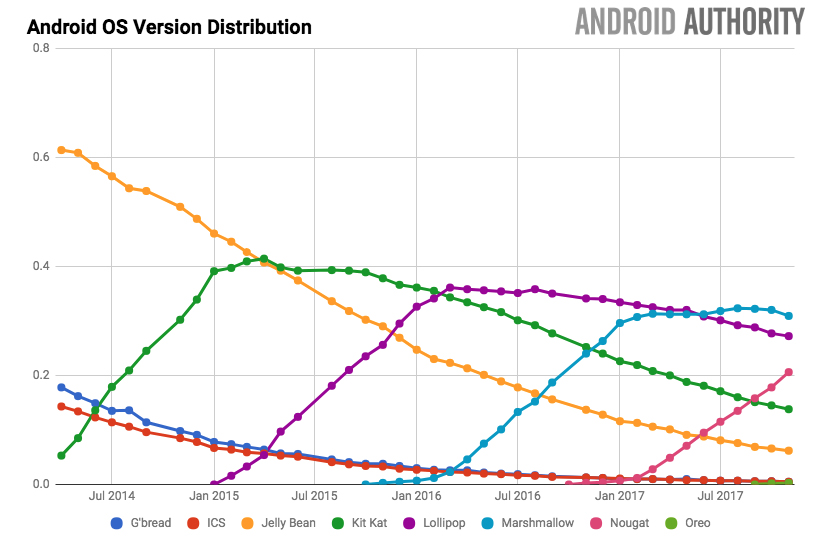
The first Android distribution numbers of 2018 are in, and while
Gingerbread stubbornly clings to life, Nougat has seen a significant
jump.
Judging by Google’s official statistics,
Android distribution numbers are heading in the right direction: both
Oreo and Nougat have gone up compared to last December, and everything
else has either stayed the same or gone down. More specifically, Android
Oreo has seen a 0.2-percent increase; it’s not substantial, but as
large manufacturers like Samsung and LG start rolling out the Oreo update over the next month or so, we should see a bigger jump in the near future.
Nougat, on the other hand, saw a 3-percent increase, putting it
at 26.3 percent. With the 1.1-percent decrease that Marshmallow saw, it
means that while Marshmallow is still the leader, the difference between
Marshmallow and Nougat is now only 2.3 percent. Who knows – Nougat
might finally overtake Marshmallow come February!
Similar to Marshmallow, Lollipop, KitKat, and Jelly Bean went
down by 1.2 percent, 0.6 percent, and 0.3 percent respectively. The more
interesting part, however, is that both Ice Cream Sandwich and
Gingerbread have lived on. In fact, they’ve stayed at the same 0.5
percent and 0.4 percent respectively.
Overall, January’s distribution numbers are not surprising at
all. After all, most 2017 devices launched with Nougat, and a number of
manufacturers have already updated their older devices to Nougat. Oreo,
as is the case with all Android versions, will be a different story.
Almost all flagships in 2018 will launch with Oreo, but it will take a
significant amount of time for 2017 phones to receive the update, and by
the time they do, Google will have announced Android P.
Are Android updates getting slower?
From KitKat, to Lollipop, to Marshmallow, Nougat and now Oreo,
each new version of Android appears to be hitting fewer devices and
doing so in a slower fashion (see the chart below). Why is that? It’s
possible that OEMs are becoming less concerned with rolling out updates
quickly, which would explain the weaker curve in the graph below, but
this likely isn’t the major issue (OEMs are probably well aware of the
importance consumers places on timely Android updates).
We know that people are also holding onto their phones for longer periods of time, which means the number of active devices running older versions of Android stays high. As the price of flagship phones continues to rise,
this could slow the rate of Android adoption rate even further as fewer
and fewer devices with old software versions stay in service.
Furthermore, there are still Android devices launching without
the latest version of Android out of the box, attributable to the rise
of lower-cost Chinese devices and increased market growth in developing
countries.

However, the increased rate of release for major Android versions
may be one of the big reasons for the shape of the graph above. Jelly
Bean was out for about 16 months before KitKat arrived. KitKat stuck
around for slightly over a year followed by Lollipop which just scraped
past 11 months before Marshmallow hit the scene. Then Marshmallow was
only out for ten and a half months before Nougat showed up in
mid-August. Oreo is the only software version to buck the trend,
releasing almost a year to the day after Nougat. Shorter OS version
shelf lives equal lower market penetration.
The other key factor here is that each new Android version arrives with more Android devices in circulation,
meaning its immediate impact is decreasing. When all of the major OEMs
got their flagships up and running with Ice Cream Sandwich, it
represented a significant share of Android phones because there were far
fewer of them. There are more than two billion monthly active Android devices in use now, so there is simply more ground for the latest Android version to cover.
Being on the latest version of Android isn’t as important as it
once was, though. With Play Services, for instance, Google can push out
important updates to just about every Android device without the need to
bake it into Android (thus requiring an entire software update). Plus, a good amount of OEMs
have been focusing on rolling out the latest Android security patches
to their devices, which means Android phones aren’t as vulnerable to
attacks as they once were.




No comments:
Post a Comment